
|
Now it is very bright as 8.3 mag (Feb. 27, Marco Goiato). It is observable at 8 mag for a long time from 2022 to 2023. In the Southern Hemisphere, it stays observable for a long time. In the Northern Hemisphere, it is not observable until summer.
Date(TT) R.A. (2000) Decl. Delta r Elong. m1 Best Time(A, h)
Mar. 4 2 18.66 -56 11.8 2.271 2.030 63 8.1 19:21 ( 29,-13)
Mar. 11 2 45.13 -51 50.4 2.314 2.071 63 8.2 19:27 ( 33,-11)
|
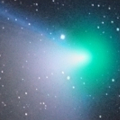
|
It approached to Earth down to 0.29 a.u. in early February, and it brightened up to 4.5 mag (Feb. 1, Juan Jose Gonzalez). Now it is fading. But it is still very bright as 8.1 mag (Feb. 28, Carlos Labordena). In the Northern Hemisphere, it stays observable until mid April. In the Southern Hemisphere, it stays observable in good condition after this.
Date(TT) R.A. (2000) Decl. Delta r Elong. m1 Best Time(A, h)
Mar. 4 4 38.92 -0 13.2 1.028 1.372 85 8.4 19:21 ( 35, 49)
Mar. 11 4 41.15 -3 0.5 1.236 1.437 79 9.0 19:27 ( 43, 43)
|
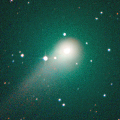
|
Now it is 10.4 mag (Feb. 26, Osamu Miyazaki). It stays bright as 10 mag for a long time until autumn. In the Northern Hemisphere, it becomes unobservable temporarily in early April. But it becomes observable again in summer. In the Southern Hemipshere, it stays unobservable until summer.
Date(TT) R.A. (2000) Decl. Delta r Elong. m1 Best Time(A, h)
Mar. 4 1 48.33 40 41.0 2.655 2.352 61 9.8 19:21 (117, 40)
Mar. 11 1 53.71 38 9.7 2.754 2.327 54 9.9 19:27 (116, 34)
|
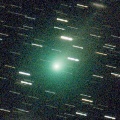
|
It brightened very rapidly. Now it is very bright as 9.9 mag (Feb. 28, Osamu Miyazaki). It stays 9-10 mag until March. In the Northern Hemisphere, it stays observable for a long time. But it locates low until spring. In the Southern Hemisphere, it is not observable until June.
Date(TT) R.A. (2000) Decl. Delta r Elong. m1 Best Time(A, h)
Mar. 4 22 37.66 50 33.9 2.065 1.745 57 9.9 5:02 (221, 19)
Mar. 11 23 0.18 48 35.9 2.167 1.756 52 10.1 4:53 (222, 18)
|

|
Now it is 12.1 mag (Feb. 8, T. Prystavski). It is expected to brighten up to 10 mag from spring to summer. In the Southern Hemisphere, it stays observable in good condition for a long time. In the Northern Hemisphere, it is not observable until 2024 autumn.
Date(TT) R.A. (2000) Decl. Delta r Elong. m1 Best Time(A, h)
Mar. 4 19 36.17 -36 38.8 3.611 3.141 54 11.2 5:02 (317, 1)
Mar. 11 19 44.43 -38 20.4 3.500 3.127 60 11.2 4:53 (320, 1)
|
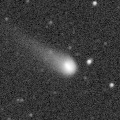
|
Now it is 11.4 mag (Feb. 25, Jose Guilherme de S. Aguiar). It stays 12 mag until summer. It stays observable in good condition for a long time.
Date(TT) R.A. (2000) Decl. Delta r Elong. m1 Best Time(A, h)
Mar. 4 12 50.18 -0 27.4 2.734 3.632 150 11.8 2:07 ( 0, 54)
Mar. 11 12 36.22 -0 46.5 2.675 3.628 160 11.8 1:25 ( 0, 54)
|

|
It brightened up to 8.3 mag in last winter (Jan. 6, 2022, Toshiyuki Takahashi). Now it is fading. But it is bright as 11.7 mag still now (Mar. 1, Giuseppe Pappa). It is observable in excellent condition in the Southern Hemisphere. It locates low in the Northern Hemisphere.
Date(TT) R.A. (2000) Decl. Delta r Elong. m1 Best Time(A, h)
Mar. 4 9 15.54 -35 7.8 4.402 5.117 131 11.9 22:27 ( 0, 20)
Mar. 11 9 11.52 -34 54.0 4.460 5.159 130 12.0 21:56 ( 0, 20)
|
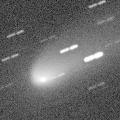
|
Now it is 12.0 mag (Feb. 27, Osamu Miyazaki). It stays 12 mag until spring.
Date(TT) R.A. (2000) Decl. Delta r Elong. m1 Best Time(A, h)
Mar. 4 17 0.24 -18 57.0 1.524 1.773 86 12.1 5:02 (339, 33)
Mar. 11 17 12.38 -19 2.8 1.486 1.803 91 12.2 4:53 (341, 34)
|
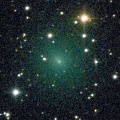
|
It brightened very rapidly up to 9.6 mag in late January (Jan. 25, Toshihiko Ikemura, Hirohisa Sato). It is still bright as 11.1 mag (Feb. 24, Jose Guilherme de S. Aguiar). It stays observable in good condition for a long time. But it will be fading after this.
Date(TT) R.A. (2000) Decl. Delta r Elong. m1 Best Time(A, h)
Mar. 4 6 5.23 12 25.0 0.869 1.508 108 12.7 19:21 ( 1, 67)
Mar. 11 6 18.18 7 34.8 0.980 1.558 104 13.3 19:27 ( 12, 62)
|
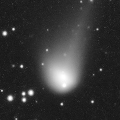
|
Now it is bright as 12.5 mag (Mar. 1, Giuseppe Pappa). It stays 13 mag until spring. It stays observable in good condition for a while after this.
Date(TT) R.A. (2000) Decl. Delta r Elong. m1 Best Time(A, h)
Mar. 4 15 43.08 7 38.5 4.367 4.783 109 12.9 4:58 ( 0, 63)
Mar. 11 15 44.26 8 56.1 4.306 4.809 114 12.9 4:32 ( 0, 64)
|
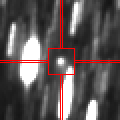
|
Now it is 13.7 mag (Feb. 26, F. Kugel, J. Nicolas). It will brighten very rapidly. It is expected to be observable at 11 mag in excellent condition from spring to summer.
Date(TT) R.A. (2000) Decl. Delta r Elong. m1 Best Time(A, h)
Mar. 4 17 54.67 -24 25.1 2.107 2.068 74 13.3 5:02 (328, 23)
Mar. 11 18 9.58 -23 46.0 2.022 2.053 77 13.0 4:53 (329, 24)
|
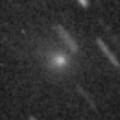
|
Bright new comet. Now it is 13.2 mag (Mar. 2, Giuseppe Pappa). In the Southern Hemisphere, it stays observable in good condition after this. In the Northern Hemisphere, it is not observable after this.
Date(TT) R.A. (2000) Decl. Delta r Elong. m1 Best Time(A, h)
Mar. 4 20 42.10 -30 0.6 1.798 1.206 39 13.1 5:02 (303, -5)
Mar. 11 20 59.40 -34 23.3 1.772 1.279 44 13.3 4:53 (307, -7)
|
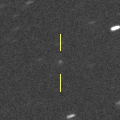
|
It brightens up to 13 mag in winter. But the condition is bad. Appearing in the morning sky in the Southern Hemisphere. It is not observable until May in the Northern Hemisphere.
Date(TT) R.A. (2000) Decl. Delta r Elong. m1 Best Time(A, h)
Mar. 4 20 58.94 -22 28.4 2.382 1.634 32 13.1 5:02 (295, -3)
Mar. 11 21 19.60 -21 21.4 2.371 1.651 34 13.1 4:53 (294, -3)
|
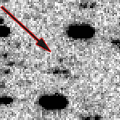
|
It approached to Sun down to 0.1 a.u. on Jan. 31. Appearing in the morning sky. It was bright as 7.0-7.5 mag in early February (Feb. 5, Michael Jager). Now it is fading rapidly. It has already faded down to 13.5 mag (Mar. 3, Giuseppe Pappa). It stays observable after this while the comet will be fading.
Date(TT) R.A. (2000) Decl. Delta r Elong. m1 Best Time(A, h)
Mar. 4 20 14.45 -7 13.2 1.472 0.960 40 13.3 5:02 (290, 14)
Mar. 11 20 16.99 -7 31.4 1.523 1.103 46 14.1 4:53 (292, 17)
|
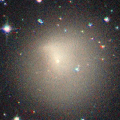
|
It brightened in major outburst in late November. Now it is still bright as 11.6 mag (Feb. 16, Toshihiko Ikemura, Hirohisa Sato).
Date(TT) R.A. (2000) Decl. Delta r Elong. m1 Best Time(A, h)
Mar. 4 6 16.60 28 26.6 5.654 6.077 110 13.6 19:30 ( 0, 83)
Mar. 11 6 17.04 28 16.6 5.764 6.079 103 13.7 19:27 ( 39, 82)
|

|
Now it is 13.8 mag (Feb. 15, Toshihiko Ikemura, Hirohisa Sato). The brightness evolution is slower than originally predicted. It stays 14 mag until summer. In the Northern Hemisphere, it will too low to observe in late March. In the Southern Hemisphere, it stays observable in good condition for a long time.
Date(TT) R.A. (2000) Decl. Delta r Elong. m1 Best Time(A, h)
Mar. 4 3 26.92 -16 48.2 2.339 2.147 66 13.7 19:21 ( 43, 26)
Mar. 11 3 32.72 -17 37.7 2.387 2.122 62 13.7 19:27 ( 48, 21)
|
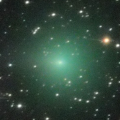
|
It brightened up to 9.7 mag in autumn (Oct. 23, Marco Goiato). Now it is fading. It has faded down to 11.6 mag in December (Dec. 15, Jose Guilherme de S. Aguiar). In the Southern Hemisphere, it stays observable in good condition for a long time, although it became unobservable temporarily from December to January. In the Northern Hemisphere, it is not observable until spring when it fades down to 15 mag.
Date(TT) R.A. (2000) Decl. Delta r Elong. m1 Best Time(A, h)
Mar. 4 19 10.95 -40 23.7 2.300 2.004 60 13.9 5:02 (324, 1)
Mar. 11 19 3.44 -41 10.3 2.201 2.057 68 14.1 4:53 (328, 4)
|
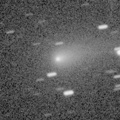
|
Now it is 13.3 mag (Feb. 15, Toshihiko Ikemura, Hirohisa Sato). It will be fading after this. It stays observable in good condition for a while.
Date(TT) R.A. (2000) Decl. Delta r Elong. m1 Best Time(A, h)
Mar. 4 8 23.77 19 14.6 1.143 2.012 140 14.0 21:37 ( 0, 74)
Mar. 11 8 26.08 19 56.7 1.215 2.036 134 14.2 21:12 ( 0, 75)
|
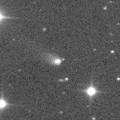
|
It brightened up to 14.5 mag in February (Feb. 16, Ken-ichi Kadota). It is expected to brighten up to 8 mag in July. Now it is not observable. In the Southern Hemisphere, it will appear in the morning sky at 13 mag in mid April, and it will be observable in excellent condition at the high light. In the Northern Hemisphere, it is not observable until June, and it becomes very low at the high lihght.
Date(TT) R.A. (2000) Decl. Delta r Elong. m1 Best Time(A, h)
Mar. 4 0 23.51 -11 54.3 3.376 2.485 22 14.1 19:21 ( 78, -4)
Mar. 11 0 24.99 -11 37.5 3.348 2.417 17 14.0 19:27 ( 83,-10)
|
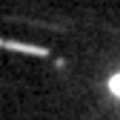
|
Now it is 15.4 mag (Feb. 21, Toshihiko Ikemura, Hirohisa Sato). It will brighten rapidly up to 14 mag and will be observable in excellent condition in spring. In the Northern Hemisphere, it is observable in good condition in winter, but it becomes somewhat low in spring.
Date(TT) R.A. (2000) Decl. Delta r Elong. m1 Best Time(A, h)
Mar. 4 14 35.55 -19 31.4 1.699 2.357 120 14.5 3:51 ( 0, 35)
Mar. 11 14 35.60 -21 6.1 1.624 2.354 126 14.3 3:24 ( 0, 34)
|
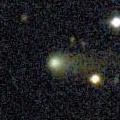
|
Now it is 14.6 mag (Feb. 15, Toshihiko Ikemura, Hirohisa Sato). It stays 14.5 mag and observable in good condition until spring.
Date(TT) R.A. (2000) Decl. Delta r Elong. m1 Best Time(A, h)
Mar. 4 9 22.38 28 7.9 2.487 3.376 149 14.5 22:35 ( 0, 83)
Mar. 11 9 21.34 28 39.1 2.542 3.381 142 14.5 22:06 ( 0, 84)
|
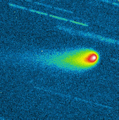
|
Now it is 14.1 mag (Feb. 15, Toshihiko Ikemura, Hirohisa Sato). It stays 14 mag in 2023. In the Southern Hemisphere, it stays observable in good condition for a long time, although it becomes unobservable temporarily from April to May. It locates somewhat low in the Northern Hemisphere.
Date(TT) R.A. (2000) Decl. Delta r Elong. m1 Best Time(A, h)
Mar. 4 2 36.10 -9 27.7 3.812 3.333 54 14.6 19:21 ( 59, 23)
Mar. 11 2 34.63 -8 10.0 3.900 3.317 47 14.7 19:27 ( 66, 18)
|
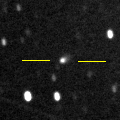
|
Now it is 14.6 mag (Feb. 17, Ken-ichi Kadota). It is expected to brighten up to 7 mag in early 2024. In the Southern Hemisphere, it stays observable in good condition for a long time. It locates low in the Northern Hemisphere.
Date(TT) R.A. (2000) Decl. Delta r Elong. m1 Best Time(A, h)
Mar. 4 5 13.20 -33 42.6 4.384 4.489 89 14.7 19:21 ( 12, 20)
Mar. 11 5 13.93 -32 45.4 4.378 4.421 85 14.7 19:27 ( 19, 19)
|
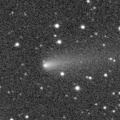
|
Now it is 14.7 mag (Feb. 16, Toshihiko Ikemura, Hirohisa Sato). It continued brightening even after the perihelion passage. It will be fading after this, and it will be fainter than 18 mag in July. It is observable in good condition in the Northern Hemisphere. It locates somewhat low in the Southern Hemisphere.
Date(TT) R.A. (2000) Decl. Delta r Elong. m1 Best Time(A, h)
Mar. 4 7 26.22 25 45.8 1.997 2.706 126 15.2 20:39 ( 0, 81)
Mar. 11 7 28.03 25 49.1 2.095 2.729 119 15.4 20:14 ( 0, 81)
|
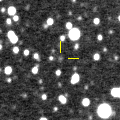
|
Now it is 15.5 mag (Feb. 22, ATLAS South Africa). It will brighten up to 13 mag from 2024 to 2025. It is observable in excllent condition in the Southern Hemisphere. It locates low in the Northern Hemisphere.
Date(TT) R.A. (2000) Decl. Delta r Elong. m1 Best Time(A, h)
Mar. 4 8 48.66 -38 12.8 5.864 6.498 126 15.3 22:01 ( 0, 17)
Mar. 11 8 46.67 -37 38.2 5.847 6.465 124 15.2 21:31 ( 0, 17)
|

|
Now it is 14.8 mag (Dec. 8, ATLAS Chile). Now it is not observable. It will become observable again in late March in the Southern Hemisphere, or in late May in the Northern Hemisphere.
Date(TT) R.A. (2000) Decl. Delta r Elong. m1 Best Time(A, h)
Mar. 4 22 27.98 -16 49.7 4.217 3.255 12 15.4 5:02 (278,-18)
Mar. 11 22 38.03 -15 53.9 4.209 3.267 16 15.4 4:53 (279,-16)
|

|
It brightened up to 13.4 mag in last summer (July 7, Giuseppe Pappa). Now it is fading. It has already faded down to 15.4 mag (Feb. 24, Toshihiko Ikemura, Hirohisa Sato). It stays 15-16 mag until summer. It stays observable in good condition for a while.
Date(TT) R.A. (2000) Decl. Delta r Elong. m1 Best Time(A, h)
Mar. 4 18 9.42 2 7.8 3.563 3.394 72 15.4 5:02 (307, 43)
Mar. 11 18 9.17 4 18.2 3.480 3.428 78 15.4 4:53 (310, 48)
|
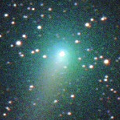
|
It brightened up to 9.3 mag in early summer in 2022 (June 5, Chris Wyatt). Now it is fading. It has already faded down to 15.7 mag (Feb. 15, Toshihiko Ikemura, Hirohisa Sato). In the Southen Hemisphere, it stays observable in good condition for a long time. It locates somewhat low in the Northern Hemisphere.
Date(TT) R.A. (2000) Decl. Delta r Elong. m1 Best Time(A, h)
Mar. 4 6 48.48 -21 18.9 3.100 3.605 113 15.5 20:01 ( 0, 34)
Mar. 11 6 44.79 -18 43.6 3.238 3.669 107 15.7 19:30 ( 0, 36)
|
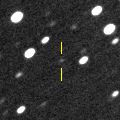
|
Now it is 15.4 mag (Feb. 17, Toshihiko Ikemura, Hirohisa Sato). It is expected to brighten up to 12-13 mag from 2024 to 2025.
Date(TT) R.A. (2000) Decl. Delta r Elong. m1 Best Time(A, h)
Mar. 4 9 32.80 -14 44.7 5.134 6.014 150 15.8 22:45 ( 0, 40)
Mar. 11 9 26.58 -13 37.7 5.119 5.970 146 15.8 22:11 ( 0, 41)
|
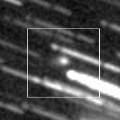
|
Now it is 16.2 mag (Feb. 21, Toshihiko Ikemura, Hirohisa Sato). It is expected to brighten up to 11.5 mag in 2024 spring. It stays observable in good condition for a long time. Appearing in the morning sky also in the Southern Hemisphere. At the high light, it will be observable in excellent condition in the Southern Hemisphere, but it will be low in the Northern Hemisphere.
Date(TT) R.A. (2000) Decl. Delta r Elong. m1 Best Time(A, h)
Mar. 4 18 37.17 16 3.1 4.852 4.576 68 16.0 5:02 (285, 48)
Mar. 11 18 37.36 16 34.3 4.708 4.525 73 15.9 4:53 (289, 51)
|
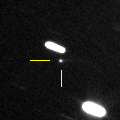
|
Now it is 17.2 mag (Feb. 21, Toshihiko Ikemura, Hirohisa Sato). It will brighten very rapidly up to 11.5 mag in April. In the Southern Hemisphere, it stays observable in good condition for a long time. In the Northern Hemisphere, it is not observable from mid April to mid June.
Date(TT) R.A. (2000) Decl. Delta r Elong. m1 Best Time(A, h)
Mar. 4 13 48.49 23 35.3 0.433 1.335 135 16.6 3:03 ( 0, 78)
Mar. 11 14 9.92 25 35.7 0.347 1.261 134 16.1 2:57 ( 0, 80)
|
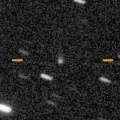
|
Now it is 15.6 mag (Feb. 17, Toshihiko Ikemura, Hirohisa Sato). It stays observable at 16 mag for a long time from early 2023 to early 2024. In the Northern Hemisphere, it is observable only until 2023 spring.
Date(TT) R.A. (2000) Decl. Delta r Elong. m1 Best Time(A, h)
Mar. 4 9 4.48 -6 6.2 3.255 4.138 149 16.2 22:16 ( 0, 49)
Mar. 11 8 55.63 -6 31.5 3.284 4.111 141 16.2 21:40 ( 0, 48)
|
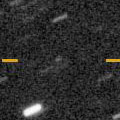
|
Now it is 17.9 mag (Feb. 26, Toshihiko Ikemura, Hirohisa Sato). It stays observable at 14-15 mag from spring to autumn. It locates somewhat low in the Northern Hemisphere.
Date(TT) R.A. (2000) Decl. Delta r Elong. m1 Best Time(A, h)
Mar. 4 17 51.66 -13 37.6 3.218 3.115 75 16.4 5:02 (323, 33)
Mar. 11 17 59.30 -13 55.9 3.109 3.098 80 16.2 4:53 (326, 34)
|

|
It was observed at 15 mag from 2021 to 2022. Now it is fading. Now it is 16.3 mag (Feb. 11, J.-C. Merlin, D. De Martin). In the Southern Hemisphere, it stays observable in excellent condition for a long time. In the Northern Hemiphere, it is not observable after this.
Date(TT) R.A. (2000) Decl. Delta r Elong. m1 Best Time(A, h)
Mar. 4 14 51.28 -70 21.3 6.053 6.195 93 16.3 4:08 ( 0,-15)
Mar. 11 14 38.59 -71 25.6 6.006 6.225 98 16.3 3:28 ( 0,-16)
|
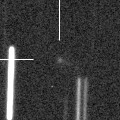
|
Now it is 16.8 mag (Feb. 11, Giuseppe Pappa). It will brighten up to 13 mag in summer. In the Northern Hemisphere, it stays observable in good condition for a long time. In the Southern Hemisphere, it is not observable until August.
Date(TT) R.A. (2000) Decl. Delta r Elong. m1 Best Time(A, h)
Mar. 4 3 36.43 76 31.7 1.796 2.081 91 16.5 19:21 (168, 45)
Mar. 11 3 1.63 73 58.7 1.846 2.014 84 16.4 19:27 (162, 43)
|
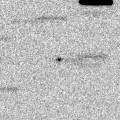
|
Now it is 16.5 mag (Feb. 25, Toshihiko Ikemura, Hirohisa Sato). It is observable at 16.5 mag in good condition from January to March. It locates somewhat low in the Southern Hemisphere.
Date(TT) R.A. (2000) Decl. Delta r Elong. m1 Best Time(A, h)
Mar. 4 13 32.27 31 0.1 0.382 1.294 136 16.4 2:48 ( 0, 86)
Mar. 11 13 36.30 31 11.5 0.402 1.321 138 16.5 2:24 ( 0, 86)
|
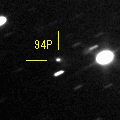
|
Now it is 16.6 mag (Feb. 21, ATLAS Chile). It is observable at 16.5 mag in good condition in spring. It locates somewhat low in the Southern Hemisphere.
Date(TT) R.A. (2000) Decl. Delta r Elong. m1 Best Time(A, h)
Mar. 4 8 13.33 28 55.1 1.476 2.292 135 16.5 21:26 ( 0, 84)
Mar. 11 8 13.11 28 45.2 1.524 2.281 128 16.4 20:59 ( 0, 84)
|

|
Now it is 15.8 mag (Feb. 22, ATLAS South Africa). It was expected to brighten up to 13 mag in 2022 spring. But actually, it was fainter than originally expected. In the Southern Hemisphere, it stays observable in good condition for a long time, although it becomes unobservable temporarily from April to May. In the Northern Hemisphere, it will be unobservable in March.
Date(TT) R.A. (2000) Decl. Delta r Elong. m1 Best Time(A, h)
Mar. 4 2 16.60 -21 8.3 4.541 3.982 50 16.5 19:21 ( 54, 12)
Mar. 11 2 18.79 -19 26.1 4.653 4.022 45 16.6 19:27 ( 60, 7)
|
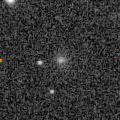
|
Now it is 16.2 mag (Feb. 16, Toshihiko Ikemura, Hirohisa Sato). It moves along an almost circular orbit. It seems to be bright temporarily in outburst.
Date(TT) R.A. (2000) Decl. Delta r Elong. m1 Best Time(A, h)
Mar. 4 10 51.60 25 35.1 5.196 6.143 161 16.5 0:08 ( 0, 80)
Mar. 11 10 48.51 25 50.5 5.217 6.142 156 16.5 23:33 ( 0, 81)
|

|
It will approach to Sun down to 0.8 a.u. in April, and it will brighten up to 15 mag. In the Southern Hemisphere, it stays observable in the extremely low sky. In the Northern Hemisphere, it is not observable after March.
Date(TT) R.A. (2000) Decl. Delta r Elong. m1 Best Time(A, h)
Mar. 4 20 16.95 -18 51.0 1.535 1.015 40 17.1 5:02 (298, 7)
Mar. 11 20 54.41 -17 7.6 1.509 0.960 38 16.5 4:53 (294, 4)
|
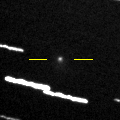
|
Now it is 16.5 mag (Feb. 23, Toshihiko Ikemura, Hirohisa Sato). In the Northern Hemisphere, it stays observable at 16.5 mag in excellent condition from February to March. In the Southern Hemisphere, it is not observable until late March.
Date(TT) R.A. (2000) Decl. Delta r Elong. m1 Best Time(A, h)
Mar. 4 8 58.30 68 25.4 1.189 1.844 115 16.5 22:06 (180, 57)
Mar. 11 8 6.13 61 1.6 1.216 1.837 112 16.6 20:50 (180, 65)
|
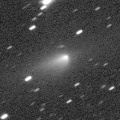
|
It brightened up to 12.7 mag in last year (Feb. 27, 2022, Jose Guilherme de S. Aguiar). Now it is fading. Appearing in the morning sky. In the Southern Hemisphere, it stays observable until summer when it becomes fainter than 18 mag. It locates low in the Northern Hemisphere.
Date(TT) R.A. (2000) Decl. Delta r Elong. m1 Best Time(A, h)
Mar. 4 18 59.90 -25 35.4 3.049 2.683 59 16.6 5:02 (316, 14)
Mar. 11 19 10.38 -25 26.8 2.991 2.707 64 16.7 4:53 (317, 15)
|
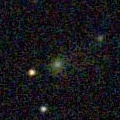
|
It brightened rapidly. Now it is 16.2 mag (Feb. 17, Ken-ichi Kadota). It will be fading after this. It will be fainter than 18 mag in April.
Date(TT) R.A. (2000) Decl. Delta r Elong. m1 Best Time(A, h)
Mar. 4 9 56.83 21 44.7 1.100 2.057 159 16.7 23:09 ( 0, 77)
Mar. 11 9 54.20 22 3.7 1.154 2.084 151 16.9 22:39 ( 0, 77)
|
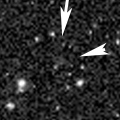
|
Now it is 16.7 mag (Feb. 23, ATLAS South Africa). Very far object. It stays 16-17 mag for a long time from 2021 to 2026. In the Southern Hemisphere, it stays observable in good condition for a long time. In the Northern Hemisphere, it is not observable at all.
Date(TT) R.A. (2000) Decl. Delta r Elong. m1 Best Time(A, h)
Mar. 4 5 5.08 -73 15.9 10.458 10.404 84 16.9 19:21 ( 5,-19)
Mar. 11 5 0.91 -72 35.9 10.446 10.399 84 16.8 19:27 ( 8,-19)
|
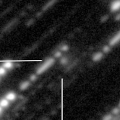
|
Now it is 17.2 mag (Feb. 8, J.-C. Merlin, D. De Martin). It brightens up to 16.5 mag from March to April. In the Southern Hemisphere, it stays observable in excellent condition. In the Northern Hemisphere, it is not observable until the end of March.
Date(TT) R.A. (2000) Decl. Delta r Elong. m1 Best Time(A, h)
Mar. 4 11 31.84 -55 40.5 1.053 1.745 117 17.0 0:47 ( 0, -1)
Mar. 11 11 38.58 -54 4.4 1.001 1.743 121 16.9 0:27 ( 0, 1)
|
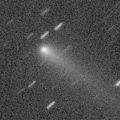
|
It brightened up to 14.1 mag in autumn (Nov. 14, Thomas Lehmann). Now it is fading. It has already faded down to 16.3 mag (Feb. 16, Toshihiko Ikemura, Hirohisa Sato). In the Northern Hemisphere, it stays observable in excellent condition for a while. In the Southern Hemisphere, it will be unobservable soon.
Date(TT) R.A. (2000) Decl. Delta r Elong. m1 Best Time(A, h)
Mar. 4 3 14.88 34 12.4 2.759 2.651 73 16.9 19:21 (102, 55)
Mar. 11 3 26.92 34 53.5 2.862 2.675 69 17.1 19:27 (104, 51)
|
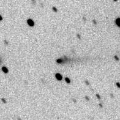
|
Now it is 16.4 mag (Feb. 17, Toshihiko Ikemura, Hirohisa Sato). It will be fading and getting lower gradually after this. It will be unobservable in April in the Northern Hemisphere, or in May in the Southern Hemisphere.
Date(TT) R.A. (2000) Decl. Delta r Elong. m1 Best Time(A, h)
Mar. 4 4 19.19 2 52.0 3.556 3.540 81 17.0 19:21 ( 44, 49)
Mar. 11 4 24.75 3 28.9 3.657 3.547 75 17.1 19:27 ( 53, 45)
|
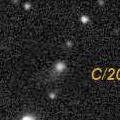
|
Now it is 17.0 mag (Feb. 24, Toshihiko Ikemura, Hirohisa Sato). It stays 17 mag and observable in good condition until summer.
Date(TT) R.A. (2000) Decl. Delta r Elong. m1 Best Time(A, h)
Mar. 4 13 16.49 8 57.3 8.086 8.919 145 17.0 2:32 ( 0, 64)
Mar. 11 13 12.43 9 34.1 8.035 8.925 152 17.0 2:01 ( 0, 64)
|

|
It brightened very rapidly up to 15.5 mag from last autumn to last winter (Nov. 2, 2021, Toshihiko Ikemura, Hirohisa Sato). Now it is fading slowly. It has already faded down to 16.7 mag (Feb. 17, Toshihiko Ikemura, Hirohisa Sato).
Date(TT) R.A. (2000) Decl. Delta r Elong. m1 Best Time(A, h)
Mar. 4 6 11.02 10 33.8 4.234 4.659 109 17.1 19:24 ( 0, 66)
Mar. 11 6 12.48 10 46.8 4.356 4.680 102 17.2 19:27 ( 17, 65)
|
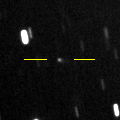
|
Now it is 17.2 mag (Feb. 21, Toshihiko Ikemura, Hirohisa Sato). In the Northern Hemisphere, it stays observable at 17 mag in good condition from spring to summer. In the Southern Hemisphere, it locates extremely low only in summer.
Date(TT) R.A. (2000) Decl. Delta r Elong. m1 Best Time(A, h)
Mar. 4 13 17.19 47 37.9 2.556 3.275 129 17.2 2:33 (180, 78)
Mar. 11 13 17.35 49 33.9 2.532 3.244 128 17.2 2:05 (180, 76)
|

|
It has not been observed yet in this apparition. In the last apparition, it had faded before the perihelion passage. If it becomes as bright as its last apparition, it will brighten up to 17 mag. It stays observable in good condition for a long time.
Date(TT) R.A. (2000) Decl. Delta r Elong. m1 Best Time(A, h)
Mar. 4 14 15.35 1 47.1 2.092 2.836 130 17.3 3:31 ( 0, 57)
Mar. 11 14 16.18 2 27.1 2.013 2.819 136 17.2 3:04 ( 0, 57)
|
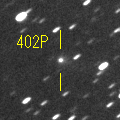
|
It brightened up to 15.3 mag in last winter (Jan. 12, 2022, H. Nohara). Now it is fading. It has already faded down to 17.3 mag (Feb. 16, Toshihiko Ikemura, Hirohisa Sato). It will be observable at 17 mag in good condition in next winter. It locates low in the Southern Hemisphere.
Date(TT) R.A. (2000) Decl. Delta r Elong. m1 Best Time(A, h)
Mar. 4 10 1.50 29 49.8 3.736 4.644 153 17.2 23:14 ( 0, 85)
Mar. 11 9 58.24 30 20.8 3.799 4.664 146 17.3 22:43 ( 0, 85)
|
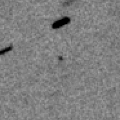
|
Now it is 17.3 mag (Feb. 16, Toshihiko Ikemura, Hirohisa Sato). It stays observable at 17 mag from spring to early summer. It locates low in the Southern Hemisphere.
Date(TT) R.A. (2000) Decl. Delta r Elong. m1 Best Time(A, h)
Mar. 4 9 14.98 38 18.7 1.790 2.635 140 17.3 22:27 (180, 87)
Mar. 11 9 11.63 38 22.5 1.828 2.622 134 17.3 21:57 (180, 87)
|
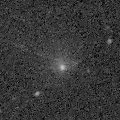
|
Now it is 17.2 mag (Feb. 23, ATLAS South Africa). Very large comet. It is expected to brighten up to 14 mag in 2031. In the Southern Hemisphere, it stays observable in good condition for a long time. In the Northern Hemisphere, it is not observable until 2030.
Date(TT) R.A. (2000) Decl. Delta r Elong. m1 Best Time(A, h)
Mar. 4 2 33.00 -58 23.4 18.305 17.926 66 17.3 19:21 ( 26,-14)
Mar. 11 2 34.93 -58 9.1 18.287 17.901 65 17.3 19:27 ( 29,-16)
|
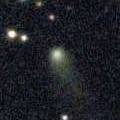
|
Now it is 17.1 mag (Feb. 24, Toshihiko Ikemura, Hirohisa Sato). Fading slowly. In the Southern Hemisphere, it is not observable after this.
Date(TT) R.A. (2000) Decl. Delta r Elong. m1 Best Time(A, h)
Mar. 4 18 30.38 49 14.5 6.270 6.180 80 17.4 5:02 (232, 57)
Mar. 11 18 35.67 50 29.6 6.279 6.214 81 17.4 4:53 (229, 59)
|

|
Now it is 17.5 mag (Feb. 25, Toshihiko Ikemura, Hirohisa Sato). Fading slowly. In the Northern Hemisphere, it stays observable in good condition for a long time. In the Southern Hemisphere, it is not observable after this.
Date(TT) R.A. (2000) Decl. Delta r Elong. m1 Best Time(A, h)
Mar. 4 18 30.94 70 4.2 9.731 9.757 88 17.4 5:02 (200, 49)
Mar. 11 18 32.60 71 0.8 9.754 9.774 88 17.4 4:53 (197, 49)
|
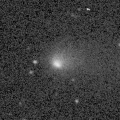
|
It brightened up to 14.6 mag in autumn (Oct. 19, Toshihiko Ikemura, Hirohisa Sato). Now it is fading. It has already faded down to 17.6 mag (Feb. 16, Toshihiko Ikemura, Hirohisa Sato). It will be fainter than 18 mag in spring.
Date(TT) R.A. (2000) Decl. Delta r Elong. m1 Best Time(A, h)
Mar. 4 3 9.90 12 2.7 2.571 2.344 65 17.4 19:21 ( 72, 44)
Mar. 11 3 22.10 13 0.2 2.666 2.365 61 17.6 19:27 ( 77, 40)
|
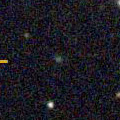
|
Now it is 17.4 mag (Feb. 16, Toshihiko Ikemura, Hirohisa Sato). It stays 17 mag for a long time from 2023 to 2024. It is observable in good condition in the Northern Hemisphere. It locates low in the Southern Hemisphere.
Date(TT) R.A. (2000) Decl. Delta r Elong. m1 Best Time(A, h)
Mar. 4 2 37.63 28 29.9 7.356 6.976 63 17.6 19:21 ( 97, 45)
Mar. 11 2 41.68 28 43.1 7.440 6.963 57 17.6 19:27 (101, 40)
|
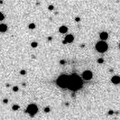
|
Now it is 17.6 mag (Feb. 17, Toshihiko Ikemura, Hirohisa Sato). It will be fading after this, and it will be fainter than 18 mag in April. It locates somewhat low in the Southern Hemisphere.
Date(TT) R.A. (2000) Decl. Delta r Elong. m1 Best Time(A, h)
Mar. 4 5 50.36 25 47.8 3.568 3.942 104 17.6 19:21 ( 23, 80)
Mar. 11 5 53.06 25 43.6 3.672 3.945 98 17.7 19:27 ( 51, 76)
|

|
It will approach to Sun down to 0.4 a.u. in late September in 2024, and it is expected to brighten up to 0 mag. Now it is 18.0 mag (Feb. 28, A. Hale). It stays observable in good condition for a while. At the high light, in the Northern Hemisphere, it will be observable in good condition after the perihelion passage. In the Southern Hemisphere, it will be observable in the low sky before and after the perihelion passage.
Date(TT) R.A. (2000) Decl. Delta r Elong. m1 Best Time(A, h)
Mar. 4 15 21.00 -0 57.1 6.776 7.230 113 17.7 4:36 ( 0, 54)
Mar. 11 15 19.22 -0 37.0 6.611 7.169 120 17.7 4:07 ( 0, 54)
|
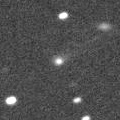
|
It brightened up to 15.9 mag in 2022 spring (May 5, Toshiyuki Takahashi). Now it is 17.5 mag (Feb. 27, ATLAS South Africa). In 2023, it is observable at 17.5 mag in spring.
Date(TT) R.A. (2000) Decl. Delta r Elong. m1 Best Time(A, h)
Mar. 4 16 26.74 -23 55.0 4.690 4.862 94 17.8 5:02 (349, 30)
Mar. 11 16 28.99 -24 6.0 4.588 4.868 100 17.8 4:53 (354, 31)
|
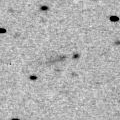
|
Now it is 18.5 mag (Feb. 21, Toshihiko Ikemura, Hirohisa Sato). It stays observable at 18 mag in good condition from January to March.
Date(TT) R.A. (2000) Decl. Delta r Elong. m1 Best Time(A, h)
Mar. 4 10 16.05 15 12.1 3.216 4.188 166 17.8 23:28 ( 0, 70)
Mar. 11 10 12.92 15 34.9 3.242 4.186 159 17.8 22:58 ( 0, 70)
|
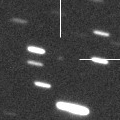
|
Now it is 18 mag (Feb. 11, Giuseppe Pappa). It stays 17.5 mag until spring. It is observable in good condition in the Northern Hemisphere. It is not observable in the Southern Hemisphere.
Date(TT) R.A. (2000) Decl. Delta r Elong. m1 Best Time(A, h)
Mar. 4 3 38.78 75 39.5 2.930 3.123 91 17.8 19:21 (168, 46)
Mar. 11 4 14.16 73 40.0 2.976 3.123 89 17.8 19:27 (166, 48)
|
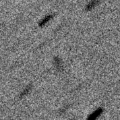
|
Now it is 17.9 mag (Feb. 20, H. Nohara). It will be fading after this, and it will be fainter than 18 mag in March. It locates somewhat low in the Southern Hemisphere.
Date(TT) R.A. (2000) Decl. Delta r Elong. m1 Best Time(A, h)
Mar. 4 11 53.80 26 14.6 1.584 2.523 156 17.8 1:10 ( 0, 81)
Mar. 11 11 49.25 27 21.9 1.601 2.540 155 17.9 0:38 ( 0, 82)
|

|
Now it is 17.5 mag (Feb. 15, Toshihiko Ikemura, Hirohisa Sato). It will be fainter than 18 mag soon.
Date(TT) R.A. (2000) Decl. Delta r Elong. m1 Best Time(A, h)
Mar. 4 8 36.65 1 7.3 2.654 3.509 144 17.9 21:49 ( 0, 56)
Mar. 11 8 35.43 1 33.0 2.711 3.514 138 17.9 21:20 ( 0, 56)
|
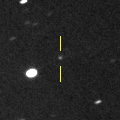
|
Now it is 17.9 mag (Feb. 19, Purple Mountain Observatory, XuYi Station). It will brighten up to 15 mag from 2024 to 2025. In 2023, it is observable at 18 mag in spring.
Date(TT) R.A. (2000) Decl. Delta r Elong. m1 Best Time(A, h)
Mar. 4 9 40.70 26 5.7 3.460 4.369 153 17.9 22:53 ( 0, 81)
Mar. 11 9 36.57 26 16.6 3.496 4.357 146 17.9 22:21 ( 0, 81)
|
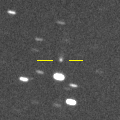
|
It was predicted to brighten up to 16 mag in 2023. But actually, it is very faint as 18.1 mag (Feb. 16, iTelescope Observatory, Siding Spring). In the Southern Hemisphere, it stays observable in good condition for a long time. In the Northern Hemisphere, it will never be observable again.
Date(TT) R.A. (2000) Decl. Delta r Elong. m1 Best Time(A, h)
Mar. 4 18 1.57 -72 57.2 3.291 3.248 78 17.9 5:02 (350,-20)
Mar. 11 18 28.97 -73 38.7 3.248 3.253 81 18.0 4:53 (350,-21)
|
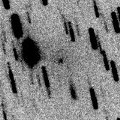
|
Tiny comet, but it approached to Sun down to 0.8 a.u. in January, and it will approach to Earth down to 0.6 a.u. in March. It was expected to brighten up to 14 mag from January to March. But actually, it became disintegrated before the perihelion passage. Now it is extremely faint as 18.2 mag (Feb. 20, Thomas Lehmann). In the Southern Hemisphere, it stays observable in good condition for a long time. It becomes observable in good condition after this also in the Northern Hemisphere.
Date(TT) R.A. (2000) Decl. Delta r Elong. m1 Best Time(A, h)
Mar. 4 5 2.65 -47 38.9 0.610 1.127 86 18.7 19:21 ( 11, 7)
Mar. 11 5 59.85 -31 56.8 0.601 1.211 95 18.9 19:27 ( 9, 23)
|
|
![]()
 C/2023 A1 ( Leonard )
C/2023 A1 ( Leonard ) 116P/Wild 4
116P/Wild 4 204P/LINEAR-NEAT
204P/LINEAR-NEAT C/2019 E3 ( ATLAS )
C/2019 E3 ( ATLAS ) C/2023 B2 ( ATLAS )
C/2023 B2 ( ATLAS ) P/2022 L3 ( ATLAS )
P/2022 L3 ( ATLAS ) 408P/2020 M7 ( Novichonok-Gerke )
408P/2020 M7 ( Novichonok-Gerke ) C/2020 F2 ( ATLAS )
C/2020 F2 ( ATLAS ) P/2021 N2 ( Fuls )
P/2021 N2 ( Fuls ) C/2022 U4 ( Bok )
C/2022 U4 ( Bok ) 280P/Larsen
280P/Larsen 402P/2020 Q3 ( LINEAR )
402P/2020 Q3 ( LINEAR ) 180P/NEAT
180P/NEAT C/2014 UN271 ( Bernardinelli-Bernstein )
C/2014 UN271 ( Bernardinelli-Bernstein ) C/2020 H6 ( ATLAS )
C/2020 H6 ( ATLAS ) C/2019 O3 ( Palomar )
C/2019 O3 ( Palomar ) 61P/Shajn-Schaldach
61P/Shajn-Schaldach C/2021 S4 ( Tsuchinshan )
C/2021 S4 ( Tsuchinshan ) 244P/Scotti
244P/Scotti C/2023 A3 ( Tsuchinshan-ATLAS )
C/2023 A3 ( Tsuchinshan-ATLAS ) 99P/Kowal 1
99P/Kowal 1 452P/2022 B5 ( Sheppard-Jewitt )
452P/2022 B5 ( Sheppard-Jewitt ) C/2022 W2 ( ATLAS )
C/2022 W2 ( ATLAS ) 211P/Hill
211P/Hill P/2021 V2 ( Fuls )
P/2021 V2 ( Fuls ) 65P/Gunn
65P/Gunn C/2021 C5 ( PanSTARRS )
C/2021 C5 ( PanSTARRS ) C/2022 S3 ( PanSTARRS )
C/2022 S3 ( PanSTARRS )![]()
































































